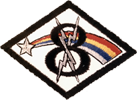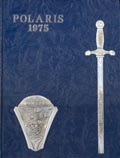Description: This patch is a black-bordered, white rhombus with a large black numeral “8” in the center. Two silver lightning bolts go through the “8.” Behind the “8,” a silver shooting star leaves a red, gold, blue, and silver trail.
Significance: The colors red, gold, blue, and silver represent the Academy’s four classes. The star represents cadets’ ultimate career goal. The lightning bolts represent the dynamic spirit and aggressiveness of the squadron.
History: This was the squadron’s first patch. It appeared in Polaris from 1965 through 1971, and was still displayed on Vandenberg Hall (Photo, Right) as late as October 1971.
 1965 – 1971
1965 – 1971



















